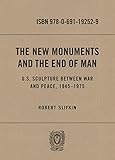The New Monuments and the End of Man : U.S. Sculpture between War and Peace, 1945–1975 / Robert Slifkin.
Material type: TextPublisher: Princeton, NJ : Princeton University Press, [2019]Copyright date: ©2019Description: 1 online resource (248 p.) : 103 b/w illusContent type:
TextPublisher: Princeton, NJ : Princeton University Press, [2019]Copyright date: ©2019Description: 1 online resource (248 p.) : 103 b/w illusContent type: - 9780691192529
- 9780691194264
- Monuments -- United States -- History -- 20th century
- Monuments
- Public sculpture, American -- 20th century
- ART / Art & Politics
- ARTnews
- Abstract expressionism
- Adolph Gottlieb
- Aesthetic Theory
- Aesthetics
- Allan Kaprow
- Allusion
- Andy Warhol
- Anthropomorphism
- Art history
- Artforum
- Barbara Rose
- Barnett Newman
- Broken Obelisk
- Buckminster Fuller
- Carl Andre
- Chinati Foundation
- Claes Oldenburg
- Clark Art Institute
- Classicism
- Clement Greenberg
- Contemporary art
- Cubism
- Curator
- Dan Flavin
- Dan Graham
- Dia Art Foundation
- Donald Judd
- Dr. Strangelove
- Erwin Panofsky
- Evocation
- Fairfield Porter
- Figurative art
- Fine art
- Frank O'Hara
- Fredric Jameson
- Harold Rosenberg
- Herbert Ferber
- Herbert Marcuse
- Iconography
- Ideology
- Illustration
- Isamu Noguchi
- Jackson Pollock
- James Rosenquist
- Jasper Johns
- Jean Tinguely
- Krannert Art Museum
- Land art
- Lawrence Alloway
- Lee Bontecou
- Leo Steinberg
- Lynn Hershman Leeson
- MIT Press
- Mark Rothko
- Max Ernst
- Michael Asher (artist)
- Michael Fried
- Minimalism
- Modern sculpture
- Modernism
- Modernity
- National Gallery of Art
- Newsweek
- Nuclear weapon
- Obsolescence
- Painting
- Patina
- Paul Thek
- Paul Virilio
- Philip K. Dick
- Photography
- Postmodernism
- Primary Structures (1966 exhibition)
- Primitivism
- Richard Serra
- Robert Goldwater
- Robert Rauschenberg
- Robert Smithson
- Ronald Bladen
- Roy Lichtenstein
- Sculpture
- Sense of Place
- Skepticism
- Smithsonian Institution
- Surrealism
- Technology
- The New York Times
- University of California Press
- Visual art of the United States
- Visual arts
- Vulgarity
- Walter Benjamin
- Welding
- Whitney Museum of American Art
- William Anastasi
- Work of art
- World War II
- Writing
- Yves Tanguy
- 730.97309/044 23
- online - DeGruyter
| Item type | Current library | Call number | URL | Status | Notes | Barcode | |
|---|---|---|---|---|---|---|---|
 eBook
eBook
|
Biblioteca "Angelicum" Pont. Univ. S.Tommaso d'Aquino Nuvola online | online - DeGruyter (Browse shelf(Opens below)) | Online access | Not for loan (Accesso limitato) | Accesso per gli utenti autorizzati / Access for authorized users | (dgr)9780691194264 |
Frontmatter -- CONTENTS -- ACKNOWLEDGMENTS -- INTRODUCTION: MONUMENTALISM AND METHOD -- CHAPTER ONE: THE NEW SENSE OF FATE -- CHAPTER TWO: SCULPTURE AND THE WEAPON -- CHAPTER THREE: NEW MONUMENTS AND REVERSED RUINS -- CHAPTER FOUR: THE CREDIBILITY GAP -- CHAPTER FIVE: THE EMPTY ROOM -- NOTES -- INDEX -- ARTWORK/PHOTO CREDITS
restricted access online access with authorization star
http://purl.org/coar/access_right/c_16ec
How leading American artists reflected on the fate of humanity in the nuclear era through monumental sculptureIn the wake of the atomic bombings of Japan in 1945, artists in the United States began to question what it meant to create a work of art in a world where humanity could be rendered extinct by its own hand. The New Monuments and the End of Man examines how some of the most important artists of postwar America revived the neglected tradition of the sculptural monument as a way to grapple with the cultural and existential anxieties surrounding the threat of nuclear annihilation.Robert Slifkin looks at such iconic works as the industrially evocative welded steel sculptures of David Smith, the austere structures of Donald Judd, and the desolate yet picturesque earthworks of Robert Smithson. Transforming how we understand this crucial moment in American art, he traces the intersections of postwar sculptural practice with cybernetic theory, science-fiction cinema and literature, and the political debates surrounding nuclear warfare. Slifkin identifies previously unrecognized affinities of the sculpture of the 1940s and 1950s with the minimalism and land art of the 1960s and 1970s, and acknowledges the important contributions of postwar artists who have been marginalized until now, such as Raoul Hague, Peter Grippe, and Robert Mallary.Strikingly illustrated throughout, The New Monuments and the End of Man spans the decades from Hiroshima to the Fall of Saigon, when the atomic bomb cast its shadow over American art.
Mode of access: Internet via World Wide Web.
In English.
Description based on online resource; title from PDF title page (publisher's Web site, viewed 27. Jan 2023)


